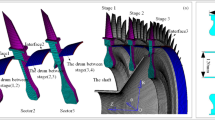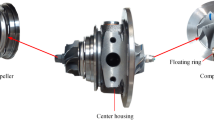Abstract
Purpose
In this paper, the combined rotor system of turbo-generator is taken as the research object, and the variation law of interface contact stress, contact stiffness and torsional natural frequency of the combined rotor system during operation is deeply analyzed.
Method
A three-dimensional cross-scale dynamic model of the rotor is proposed based on the detailed research of the contact stress distribution characteristics and the contact stiffness between the combined rotor interfaces. By comparing the 3D simulation results with the experimental results, the essential reason why the natural frequency of the combined rotor varies with working conditions is explained. On this basis, by studying the influence of key structural parameters on the torsional vibration natural frequency of the combined rotor, a design method of torsional vibration natural frequency of the combined rotor based on the adjustment of structural parameters was proposed.
Results and conclusions
This paper provides an important reference and theoretical basis for the dynamic characteristic design of turbo generator combined rotor system. The simulation analysis accurately revealed the phenomenon of static and dynamic frequency drift in the turbo generator rotor system. Through the comparison with the measured results of the generator rotor, the simulation results of the three-dimensional cross-scale model are closer to the reality than other models, with higher accuracy. Through cross-scale dynamic simulation, it can be found that the interface contact stress and torsion natural frequency in the combined rotor have obvious coupling characteristics. Through the analysis of the key factors influencing the dynamic characteristics of the turbo generator rotor system, improving the interface stiffness of the rotor structure can effectively improve the torsional natural frequency of the system. The design of the long slot wedge, the high elastic modulus slot wedge, the improvement of the fit between the slot wedge and the rotating shaft, and the enhancement of the interface contact stress all effectively increase the stiffness of the system, thus increasing the natural frequency of the turbo generator rotor system.
































Similar content being viewed by others

References
Hall MC, Hodges DA (1977) Experience with 500 kv subsynchronous resonance and resulting turbine generator shaft damage at Mohave Generating Station. IEEE publ. 76CH1066-0-PWR, pp 22–29
Walker D, Bowler C, Jackson R, Hodges D (1975) Results of sub synchronous resonance test at Mohave. IEEE Trans Power Appar Syst 94(5):1878–1889
Wenzhi G, Zhiyong H (2010) Active control and simulation test study on torsional vibration of large turbo-generator rotor shaft. Mech Mach Theory 45(9):1326–1336
Feng L et al (2010) Observer-based active control of torsional vibration for large turbine-generator shaft system. 2010 Asia-Pacific power and energy engineering conference, IEEE
Liska J et al (2019) Measurement and evaluation of shaft torsional vibrations using shaft instantaneous angular velocity. J Eng Gas Turbines Power 141(4):1–6
Triezenberg D (1980) Characteristic frequencies and mode shapes for turbo-generator shaft torsional vibrations. IEEE Trans Power Appar Syst 1:352–357
Walker D et al (1981) Torsional vibration and fatigue of turbine-generator shafts. IEEE Trans Power Appar Syst 11:4373–4380
Schwibinger P, Nordmann R (1990) Torsional vibrations in turbo-generators due to network disturbances. J Vib Acoust 112:312–320
Yang B, Chen H (1993) Reduced-order shaft system models of turbo-generators. IEEE Trans Power Syst 8(3):1366–1374
Martinez JE, de la Rosa F (2001) Shaft torsional vibration due to non-linear loads in low capacity turbine units. 2001 power engineering society summer meeting. Conference proceedings (Cat. No. 01CH37262). IEEE
Zhang Z et al (2006) Response calculation and analysis of torsional vibration of turbine-generator shafts. ASME 2006 power conference. American Society of Mechanical Engineers Digital Collection
Ricci R, Pennacchi P, Pesatori E, Turozzi G (2010) Modeling and model updating of torsional behavior of an industrial steam turbo-generator. ASME J Eng Gas Turbines Power 132(7):074501
Du D et al (2007) A system of calculation and analysis of torsional vibration for turbine-generator shafts. ASME 2007 power conference. American Society of Mechanical Engineers Digital Collection
He CB et al (2012) Study on dynamic response of torsional vibration of turbo-generator unit caused by short circuit fault. Advanced Materials Research, Trans Tech Publ
Jiang D, Hong L, Wang Z, Xie X (2009) Torsional vibration analysis and stress calculation for the fault 600MW steam turbine generator shaft system, ASME Paper No. DETC, 2009-86854
Liu C et al (2014) Coupled torsional vibration and fatigue damage of turbine generator due to grid disturbance. J Eng Gas Turbines Power 136(6):062501
Liu C et al (2012) Torsional vibration and fatigue evaluation in repairing the worn shafting of the steam turbine. Eng Fail Anal 26:1–11
Yang Z, Wang Z (2017) Calculation and measurement of torsional frequency of large steam turbine-generator. Dongfang Electr Rev 3:25
BS ISO 22266-1 (2009) Mechanical vibration—torsional vibration of rotating machinery—part 1: land-based steam and gas turbine generator sets in excess of 50 MW
Li Y et al Research on dynamic characteristics of complex gap combined rotor of large generator, IMECE2019-10835
Zawoysky RJ, Tornroos KC (2001) GE Generator rotor design, operational issues, and refurbishment options. GE Power Syst Rep GER 4212(08):01
Guo X, Ma B, Zhu Y (2019) A magnification-based multi-asperity (MBMA) model of rough contact without adhesion. J Mech Phys Solids 133:103724
Carpick RW (2018) The contact sport of rough surfaces. Science 359:38
Greenwood JA, Williamson JBP (1966) Contact of nominally flat surfaces. Proc R Soc Lond Ser 295:300–319
Liu Y, Liu H, Yi J et al (2013) Investigation on the stability and bifurcation of a 3D rotor-bearing system. ASME J Vib Acoust 135:031017
Liu Y, Yi J et al (2015) Investigation on the stability and bifurcation of a rod-fastening rotor bearing system. J Vib Control JVC 21(14):2866–2880
Acknowledgements
The work described in this paper is supported by the national natural science foundation of China (51705399).
Author information
Authors and Affiliations
Corresponding author
Additional information
Publisher's Note
Springer Nature remains neutral with regard to jurisdictional claims in published maps and institutional affiliations.
Rights and permissions
About this article
Cite this article
Li, Y., Liu, Y., Liu, H. et al. Analysis of Torsional Dynamic Characteristics of Turbo-Generator Rotor Based on Cross Scale Modeling Method. J. Vib. Eng. Technol. 10, 1055–1072 (2022). https://doi.org/10.1007/s42417-021-00428-1
Received:
Revised:
Accepted:
Published:
Issue Date:
DOI: https://doi.org/10.1007/s42417-021-00428-1



